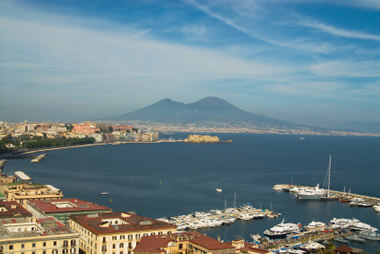[/caption]
Imagine if you will that it’s bright sunny day in summer. The festival of Vulcanalia, dedicated to the Roman God of Fire, has just passed. Now you’re out looking for some produce to stock up for the coming winter. You’ve just finished a tour of the marketplace and are on your way home when suddenly, the mountain that your town sits at the foot of inexplicably erupts! Fire and ash rain down upon your city, people are baked alive and the town is encased in soot and dirt several meters thick. But, silver lining here, your bodies are so well preserved that when you’re dug up two thousand years later, they’ll have a pretty good idea what life was like at the time of your death. Yes, that’s how the Pompeii Eruption took place. The year was 79 CE; the place, a prosperous town named Pompeii located in the Bay of Naples. It was one of the most significant natural disasters of the ancient world, a major archaeological find in the 18th century, and is now one of the biggest tourist draws in all of Italy.
Based on the letters of Pliny the Younger, historians now believe the eruption to have taken place between the 24th of August and November 23rd, in the year 79 CE. Witnessing the eruption from across the Bay of Naples, Pliny gave a fist-hand account of the destruction. Although it was generally assumed that the people of Pompeii died as a result of suffocation from volcanic ash, a recent multidisciplinary volcanological and bio-anthropological study, merged with numerical simulations and experiments, indicated that heat was the main cause of death. The results of this study show that temperatures would have reached 250 °C up to a distance of 10 kilometers, which would have been sufficient to cause instant death, even if people were sheltered within buildings. The people and buildings of Pompeii were covered in up to twelve different layers of soil which was 25 meters deep and were therefore not discovered for almost two thousand years.
However, rediscovery of the lost city started in 1738, beginning with Pompeii’s sister town of Herculaneum which had also been destroyed in the eruption. At the time, the discovery was the accidental result of workmen digging so that they could build the foundations of a new summer palace for the king of Naples. The discovery of ancient buildings, left largely intact, led to a subsequent intentional excavation of Pompeii itself in 1764 by Francisco la Vega. In addition to intact buildings, many of which contained perfectly preserved Roman frescos, human remains were also uncovered.
For over 20 years now, Pompeii has been one of the most popular tourist destinations in Italy, attracting almost 2.6 million visitors in 2008 alone. In 1997, it was designated a World Heritage Site by UNESCO and attempts are underway to ensure that it can be preserved for future generations. Though the life-blood of the local economy, the pressure exerted by millions of tourists annually is taking its toll on this once-perfectly preserved site.
We have written many articles about Pompeii Eruption for Universe Today. Here’s an article about Mt. Vesuvius, and here are interesting facts about volcanoes.
If you’d like more info on volcanoes, check out the U.S. Geological Survey Homepage. And here’s a link to NASA’s Earth Observatory.
We’ve also recorded related episodes of Astronomy Cast about Volcanoes. Listen here, Episode 141: Volcanoes, Hot and Cold.
Sources:
http://en.wikipedia.org/wiki/Pompeii#Vesuvius_eruption
http://en.wikipedia.org/wiki/Mount_Vesuvius
http://touritaly.org/pompeii/pompeii-main.htm
http://wikitravel.org/en/Pompeii

